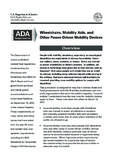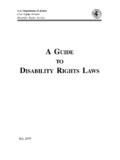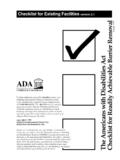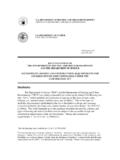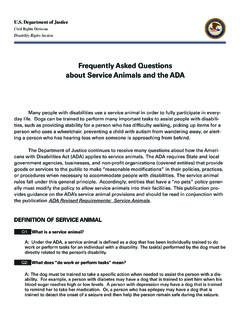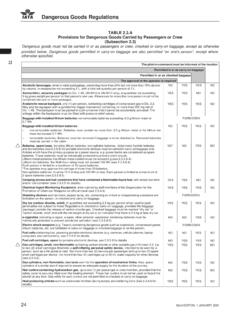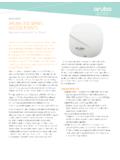Transcription of Overview - ADA
1 Department of Justice Civil Rights Division Disability Rights Section ADA. Requirements Wheelchairs, mobility Aids, and Other power -Driven mobility devices Overview The Department of People with mobility , circulatory, respiratory, or neurological disabilities use many kinds of devices for mobility . Some Justice published use walkers, canes, crutches, or braces. Some use manual revised final regulations or power wheelchairs or electric scooters. In addition, ad- implementing the vances in technology have given rise to new devices , such as Segways , that some people with disabilities use as mobil- Americans with ity devices , including many veterans injured while serving in Disabilities Act (ADA) for the military. And more advanced devices will inevitably be title II (State and local invented, providing more mobility options for people with disabilities. government services). This publication is designed to help title II entities (State and and title III (public local governments) and title III entities (businesses and non- accommodations and profit organizations that serve the public) (together, covered entities ) understand how the new rules for mobility devices commercial facilities) apply to them.
2 These rules went into effect on March 15, on September 15, 2010, 2011. in the Federal Register. Covered entities must allow people with disabilities These requirements, or who use manual or power wheelchairs or scooters, and manually-powered mobility aids such as walkers, rules, clarify and refine crutches, and canes, into all areas where members of the issues that have arisen public are allowed to go. over the past 20 years Covered entities must also allow people with disabilities and contain new, and who use other types of power -driven mobility devices into their facilities, unless a particular type of device updated, requirements, cannot be accommodated because of legitimate safety including the 2010 requirements. Where legitimate safety requirements bar accommodation for a particular type of device, Standards for Accessible the covered entity must provide the service it offers in Design (2010 Standards). alternate ways if possible. Other power Driven mobility devices The rules set out five specific factors ity, different rules apply under the ADA than to consider in deciding whether or when it is being used by a person without a not a particular type of device can be disability.
3 Accommodated. Wheelchairs Choice of Device Most people are familiar with the manual People with disabilities have the right to and power wheelchairs and electric scoot- choose whatever mobility device best suits ers used by people with mobility disabilities. their needs. For example, someone may The term wheelchair is defined in the new choose to use a manual wheelchair rather rules as a manually-operated or power - than a power wheelchair because it enables driven device designed primarily for use her to maintain her upper body strength. by an individual with a mobility disability Similarly, someone who is able to stand for the main purpose of indoor or of both may choose to use a Segway rather than indoor and outdoor locomotion. a manual wheelchair because of the health benefits gained by standing. A facility may be required to allow a type of device that Other power -Driven is generally prohibited when being used mobility devices by someone without a disability when it is being used by a person who needs it be- In recent years, some people with mobility cause of a mobility disability.
4 For example, disabilities have begun using less tradi- if golf cars are generally prohibited in a tional mobility devices such as golf cars or park, the park may be required to allow a Segways . These devices are called other golf car when it is being used because of a power -driven mobility device (OPDMD) in person's mobility disability, unless there is the rule. OPDMD is defined in the new rules a legitimate safety reason that it cannot be as any mobility device powered by batter- accommodated. ies, fuel, or other engines .. that is used by individuals with mobility disabilities for the pur- pose of locomotion, including golf cars, electronic personal assistance mobility devices such as the Segway PT, or any mobility device designed to operate in areas without defined pedestrian routes, but that is not a wheelchair . When an OPDMD is being used by a person with a mobility disabil- 2 ADA Requirements Other power Driven mobility devices accommodated in some areas of a Requirements Regarding facility, but not in others because of mobility devices and Aids legitimate safety concerns.
5 For example, a cruise ship may decide that people Under the new rules, covered entities must with disabilities using Segways can allow people with disabilities who use generally be accommodated, except in wheelchairs (including manual wheelchairs, constricted areas, such as passageways power wheelchairs, and electric scooters) to cabins that are very narrow and have and manually-powered mobility aids such as low ceilings. walkers, crutches, canes, braces, and other similar devices into all areas of a facility For other facilities such as a small where members of the public are allowed to convenience store, or a small town go. manager's office covered entities may determine that certain classes of In addition, covered entities must allow OPDMDs cannot be accommodated. In people with disabilities who use any that case, they are still required to serve OPDMD to enter the premises unless a par- a person with a disability using one of ticular type of device cannot be accommo- these devices in an alternate manner dated because of legitimate safety require- if possible, such as providing curbside ments.
6 Such safety requirements must be service or meeting the person at an based on actual risks, not on speculation or alternate location. stereotypes about a particular type of device or how it might be operated by people with Covered entities are encouraged to develop disabilities using them. written policies specifying which kinds of OPDMDs will be permitted and where and For some facilities -- such as a when they will be permitted, based on the hospital, a shopping mall, a large following assessment factors. home improvement store with wide aisles, a public park, or an outdoor amusement park covered entities will likely determine that certain classes of OPDMDs being used by people with disabilities can be accommodated. These entities must allow people with disabilities using these types of OPDMDs into all areas where members of the public are allowed to go. In some cases, even in facilities such as those described above, an OPDMD can be ADA Requirements 3. Other power Driven mobility devices whether legitimate safety requirements Assessment Factors (such as limiting speed to the pace of pedestrian traffic or prohibiting use on escalators) can be established to permit In deciding whether a particular type of the safe operation of the OPDMD in the OPDMD can be accommodated in a particu- specific facility; and lar facility, the following factors must be considered: whether the use of the OPDMD creates a substantial risk of serious harm to the the type, size, weight, dimensions, and immediate environment or natural or speed of the device; cultural resources, or poses a conflict with Federal land management laws and the facility's volume of pedestrian traffic regulations.
7 (which may vary at different times of the day, week, month, or year); It is important to understand that these as- sessment factors relate to an entire class the facility's design and operational of device type, not to how a person with a characteristics ( , whether its disability might operate the device. (See business is conducted indoors or next topic for operational issues.) All types outdoors, its square footage, the density of devices powered by fuel or combustion and placement of furniture and other engines, for example, may be excluded from stationary devices , and the availability indoor settings for health or environmental of storage for the OPDMD if needed and reasons, but may be deemed acceptable requested by the user); in some outdoor settings. Also, for safety reasons, larger electric devices such as golf cars may be excluded from narrow or crowded settings where there is no valid reason to exclude smaller electric devices like Segways . Based on these assessment factors, the Department of Justice expects that de- vices such as Segways can be accom- modated in most circumstances.
8 The Department also expects that, in most circumstances, people with disabilities using ATVs and other combustion engine- driven devices may be prohibited indoors and in outdoor areas with heavy pedes- trian traffic. 4 ADA Requirements Other power Driven mobility devices verbally that the OPDMD is being used be- Policies on the Use of OPDMDs cause of a mobility disability, that also must be accepted as credible assurance, unless In deciding whether a type of OPDMD can the person is observed doing something be accommodated, covered entities must that contradicts the assurance. For example, consider all assessment factors and, where if a person is observed running and jump- appropriate, should develop and publicize ing, that may be evidence that contradicts rules for people with disabilities using these the person's assertion of a mobility disabili- devices . ty. However, it is very important for covered entities and their staff to understand that the Such rules may include fact that a person with a disability is able to walk for a short distance does not neces- requiring the user to operate the device sarily contradict a verbal assurance -- many at the speed of pedestrian traffic; people with mobility disabilities can walk, but need their mobility device for longer dis- identifying specific locations, terms, or tances or uneven terrain.
9 This is particularly circumstances (if any) where the devices true for people who lack stamina, have poor cannot be accommodated; balance, or use mobility devices because of respiratory, cardiac, or neurological dis- setting out instructions for going abilities. A covered entity cannot ask people through security screening machines about their disabilities. if the device contains technology that could be harmed by the machine; and specifying whether or not storage is available for the device when it is not being used. Credible Assurance An entity that determines it can ac- commodate one or more types of OPDMDs in its facility is allowed to ask the person using the device to provide credible assurance that the device is used because of a disability. If the person presents a valid, State-issued disability parking placard or card or a State-issued proof of disability, that must be accepted as credible assur- ance on its face. If the person does not have this documentation, but states ADA Requirements 5.
10 Other power Driven mobility devices Staff Training Ongoing staff training is essential to ensure that people with disabilities who use OPDMDs for mobility are not turned away or treated inappropriately. Training should include instruction on the types of OPDMDs For more information about the ADA, that can be accommodated, the rules for please visit our website obtaining credible assurance that the device or call our toll-free number. is being used because of a disability, and the rules for operation of the devices within the ADA Website: facility. To receive e-mail notifications when new ADA information is available, visit the ADA Website and click on the link near the bottom of the right-hand column. ADA Information Line 800-514-0301 (Voice) and 800-514-0383 (TTY). Call M-W, F 9:30 5:30 , Th 12:30 5:30 (Eastern Time) to speak with an ADA Specialist (calls are confidential) or call 24 hours a day to order publications by mail. For people with disabilities, this publication is available in alternate formats.
